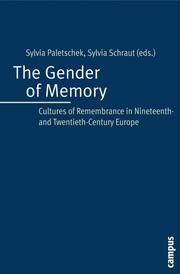-
Zusatztext
-
Wie werden Frauen in den nationalen Erinnerungskulturen europäischer Länder repräsentiert? Wie wird an Frauen erinnert in Zusammenhang mit Krieg und Gewalt? Dieser Band macht deutlich, dass einem öffentlichen Gedenken, das weibliche Erfahrungen einbezieht, bisher enge Grenzen gesetzt sind. Eine Reflexion der Erinnerungskultur unter Genderaspekten ist ebenso geboten wie eine Dekonstruktion des nationalen Bezugrahmens.
-
-
Kurztext
-
Wie werden Frauen in den nationalen Erinnerungskulturen europäischer Länder repräsentiert? Wie wird an Frauen erinnert in Zusammenhang mit Krieg und Gewalt? Dieser Band macht deutlich, dass einem öffentlichen Gedenken, das weibliche Erfahrungen einbezieht, bisher enge Grenzen gesetzt sind. Eine Reflexion der Erinnerungskultur unter Genderaspekten ist ebenso geboten wie eine Dekonstruktion des nationalen Bezugrahmens.
-
-
Autorenportrait
- Sylvia Paletschek ist Professorin für Neueste Geschichte an der Universität Freiburg. Sylvia Schraut ist außerplanmäßige Professorin am Historischen Institut der Universität der Bundeswehr München.
-
Leseprobe
- To date, studies of the representation of women in national memory and of the role of gender in memory culture have been rare. A closer examination of the current state of research reveals the following features: European national cultures of memory are male-connoted and orientated towards the bourgeois gender-model. Women as agents are scarce, their spaces of agency and their self-images and aims are often marginalized. This exclusion of women from the nation is reproduced in nineteenth-century national cultures of memory and is thus reinforced. From a historical perspective, national cultures of memory are a relatively new phenomenon. The shaping of a national memory culture has been a significant part of nation building since the nineteenth century. A national culture of memory in the form of monuments, remembrance days or celebrations served the shaping of a national consciousness, defined in a variety of ways, often in delimitation from other nations and sometimes by way of excluding particular groups of the collective. Although women were considered an integral part of the nation and although bourgeois women contributed to the building of the nation as members of clubs, by collecting money and by publications, they were excluded from the body politic of the nation and they were denied civil rights. The representation of the nation and its delimitation from other nations were also gendered: as early as the beginning of the nineteenth century, when national movements emerged, the national community was depicted as masculine and courageous, the enemy disparaged as weak and effeminate. The masculine imbuement of national cultures of memory is reflected in the prevailing concepts of research into cultural memory; it is not the subject of critical examination. This can be shown with the example of Pierre Nora's concept "lieu de mémoire". Nora's interest is directed at historically anchored national identity. He exclusively refers to the nation and his concern is the safeguarding of national memory at present or in the future. Nora's concept runs the risk of drawing an image of history that is centered on male spheres of action. This can be demonstrated with the example of its implementation in Etienne François and Hagen Schulze's project on "German places of memory". There have been many discussions about the concept of "lieu de mémoire" as well as about the selection of the places. Here we shall concentrate on the analysis of the implicit concept of gender in this approach. Twentyfive of the 121 contributions of "German places of memory" deal with persons, five among them with women. Accordingly, Rosa Luxemburg and Rahel Varnhagen, the Prussian Queen Luise and Marlene Dietrich represent the female element in the German places of memory. We may further add Uta von Naumburg, even if she is listed only due to the Bamberger Reiter (Bamberg horseman) who appears first in the title of the essay that deals with her. That there is a certain blindness towards questions of gender can be demonstrated with examples that seem to be genderneutral: Canossa, Nuremberg, Versailles, or Rapallo appear to be general places of memory at first sight. In fact, they are not general, as they are exclusively associated with male spheres of action. This, however, is not clearly indicated. Even symbolically charged places such as Karlsruhe, the site of the Federal Constitutional Court, or "Bürgerliches Gesetzbuch", the German civil law code, which are not that closely linked with big (foreign) politics, undoubtedly refer to a larger extent to male law makers or law interpreters than to their male and female opponents. Meanwhile a further condensed onevolume edition of the "German places of memory" has been published which, as the preface states, especially focuses on the politicalhistorical places of memory (François/Schulze 2005). Among the 29 examples not one single woman and no feminineconnoted place of remembrance can be found. This rough exemplary analysis illustrates the unsatisfactory nature of public memory culture and the accompanying scholarly debate from the perspective of gender. According to Jan Assmann, cultural memory contributes to the creation of a historically grounded identity of those who share a common culture. It reflects the public categorization, evaluation and interpretation of the historical events considered relevant by which the political and cultural self-image of a community roots itself. We therefore have to ask the following questions: Which remembrances do allow women to be inscribed into a polity when they are excluded from national memory? Which remembrances enable women to establish their own individual, political and national identity?
Detailansicht
The Gender of Memory
Cultures of Remembrance in Nineteenth- and Twentieth-Century Europe
ISBN/EAN: 9783593385495
Umbreit-Nr.: 1316081
Sprache:
Englisch
Umfang: 287 S.
Format in cm: 1.8 x 21.2 x 13.9
Einband:
Paperback
Erschienen am 13.05.2008
Auflage: 1/2008


